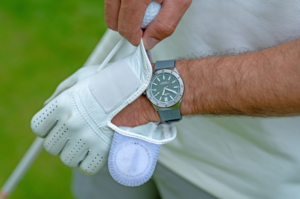Golf gloves are an essential piece of equipment for many golfers. They provide a consistent grip, prevent blisters and callouses, offer warmth in colder weather, and even allow players to emulate their favorite professional golfers.
However, for those new to the game or unfamiliar with golf gloves, it may not be immediately obvious which hand to wear the glove on. In this comprehensive guide, we will explore the fundamentals of wearing a golf glove, the importance of finding the right size and fit, and the different types of gloves suitable for varying on-course conditions.
The Lead Hand: Left or Right?
When it comes to wearing a golf glove, the general rule is that right-handed golfers wear the glove on their left hand, while left-handed golfers wear the glove on their right hand. The reason for this is that the lead hand, which is the hand at the top of the grip, plays a crucial role in providing a firm attachment to the club during the swing. By wearing a glove on the lead hand, golfers can ensure a secure grip without compromising on the freedom and tension-free movement required for a fluid swing.
Some golfers, like professional golfer Aaron Rai, choose to wear gloves on both hands for an even better grip and consistency of feel between the hands. However, this is a personal preference, and most golfers find that a well-fitted glove on the lead hand is sufficient for their needs.
Finding the Right Size and Fit
Choosing the right size and fit for your golf glove is essential for optimal performance and comfort. Most gloves come in a range of sizes to accommodate different hand shapes. When trying on a golf glove, it should fit snugly across the palm, providing a second-skin-like feel without constricting movement or cutting off the blood supply.
To ensure a proper fit, pay attention to the following:
- Palm Fit: The glove should have a snug fit across the palm, with no loose material or excess space.
- Finger Length: Ensure that there is no over-stretching or pulling when you stretch your fingers or make a fist while wearing the glove.
- Movement: The glove should allow for comfortable movement and flexibility without feeling restrictive.
- Brand Variations: Different glove brands and models may have slightly different fits and feels. Experiment with different options to find the ideal glove for your hand shape.
It’s also worth noting that there are specific golf gloves available for women and junior players, which offer sizing tailored to their hands. If you fall into either of these categories, consider checking out the best golf gloves for women and the best kids golf gloves for more options.
Types of Gloves for Varying On-Course Conditions
Golfers often encounter different weather conditions and playing environments, which may require specific types of gloves to ensure optimal performance. Let’s explore the different types of gloves suitable for varying on-course conditions.
1. Fine and Fair Weather Gloves
In favorable weather conditions, golfers can opt for premium Cabretta leather gloves or similar high-quality materials. Many manufacturers, such as Ping, TaylorMade, Callaway, and FootJoy, produce soft leather gloves favored by both professional and amateur golfers. These gloves offer exceptional comfort and a tacky grip on the club, providing excellent feedback and feel throughout the swing.
While leather gloves may not be the most durable option, they excel in delivering a superior grip and feel on shorter shots. However, they may not withstand wet weather conditions.
2. All-Weather Gloves
For changeable weather conditions, such as intermittent rain or varying temperatures, an all-weather synthetic glove is a suitable choice. Constructed from durable fabrics, these gloves offer greater longevity and are better equipped to handle wet weather compared to leather gloves.
However, during heavy rain, it’s advisable to consider specialized rain golf gloves. These gloves are specifically designed to become grippier as they get wet, providing enhanced grip and control even in the wettest conditions. Some rain gloves are sold in pairs, and wearing them on both hands can offer increased effectiveness and comfort.
3. Winter Gloves
When the temperature drops, golfers can benefit from wearing winter gloves to keep their hands warm and maintain optimal performance. Winter gloves are designed to provide insulation while still allowing for flexibility and dexterity. They are essential for playing in colder climates and can help golfers perform at their best despite the chilly weather.
To find the best golf gloves for winter, consider exploring specialized options designed specifically for colder conditions. These gloves often feature additional insulation and weather-resistant materials to keep your hands warm and comfortable throughout your round.
Conclusion
Wearing a golf glove on the lead hand, whether it’s the left or right depending on your dominant hand, is a common practice among golfers. The glove provides a consistent grip, prevents blisters and callouses, and can enhance performance in varying on-course conditions.
Remember to find the right size and fit for your golf glove, ensuring it feels like a second skin without restricting movement or being too loose. Experiment with different glove brands and models to find the one that suits your hand shape and preferences.
Lastly, consider the weather conditions you often encounter on the golf course and invest in the appropriate gloves. Fine and fair weather gloves, all-weather gloves, and winter gloves each have their advantages, allowing you to play comfortably and confidently regardless of the elements.
By understanding the importance of wearing a golf glove, finding the right fit, and choosing the appropriate glove for different conditions, you can enhance your performance and enjoyment of the game. So, next time you hit the links, make sure to slip on your golf glove and experience the difference it can make in your game!




